Best time to visit Iceland - your guide
June 24, 2022
Best time to visit Iceland - your guide
June 24, 2022
Cast out in the wild North Atlantic, Iceland is a rugged island of coastal fishing towns, raw wilderness and geothermal natural wonders. The best time to visit Iceland depends on your interests. If you want to witness a world blanketed in snow as the Northern Lights dance above, or explore the glowing blue interior of an ice cave, consider the winter months. If you’re looking to hike in the unspoilt scenery of the Highlands, or embark on a whale watching boat trip, summer might be the season for you. Whatever draws you to this unique little island, and whether you want to visit Iceland in summer or winter, we’ve compiled the ultimate guide to Iceland’s seasons and sights so you can decide the best time of year to visit Iceland for your trip.
When is the best time to visit Iceland?
If we went on numbers alone, the statistics would suggest that June to August is the best time to visit Iceland. This is considered peak season, when the most visitors flock to the island to take advantage of the long, light evenings and pleasant weather. If you want to witness the midnight sun on the longest day of the year when the solstice is celebrated in Iceland, best time to visit would be around 21st June.
If spotting the Northern Lights is at the top of your bucket list, you’ll want to avoid the summer months when the sun barely sets and head to Iceland in deepest darkest winter. The long nights give you the best chance of spotting the aurora borealis. This is also the perfect time to enjoy Iceland’s traditional bathing culture in geothermal pools like the Blue Lagoon and Sky Lagoon. There’s something magical about having a long, hot soak in a natural thermal pool as snow falls around you.
What is the best month to visit Iceland?
As we’ve mentioned, the summer months, between June and August are when the days are long and sightseeing can last long into the evening. At the end of June, the sun barely sets below to horizon and you can enjoy daylight for almost 24 hours of the day. This is also the season to head into the centre of Iceland – the raw, unspoilt wilderness of the Highlands. Outside of the summer months, the Highlands are inaccessible as they can only be reached by narrow mountain roads and crossing glacial rivers in a 4x4, so the snowfall in winters cuts off the interior from the rest of the country.
Autumn is a good choice if you don’t want to feel the deep cold of winter and prefer your sunsets at around 6pm or 7pm. You have a chance to spot the Northern Lights from September through to March, so heading to Iceland in September, October or November could still reward with a sighting of this other-worldly phenomena without having to endure the harsh temperatures of winter. This is also shoulder season when the streets of Reykjavik and the sights of the Golden Circle are less crowded with visitors.
Iceland does make for an excellent winter break though. In December, January and February, you have the best chance to spot the Northern Lights as the sun sets as early as 3pm some days. Even when the sun shines in these months, it feels as though the country is in a constant state of sunset, bathed in golden light during the limited daylight hours. It’s a photographer’s dream to visit Iceland in the winter months.
Spring can be a good compromise if you want to enjoy the sunshine without the crowds. There’s still a chance to spot the Northern Lights in March, but there’s more of a risk of missing out than in the winter months. April and May see the temperature rise and stormclouds clear, and days get longer.
Best time to visit Iceland to see the Golden Circle
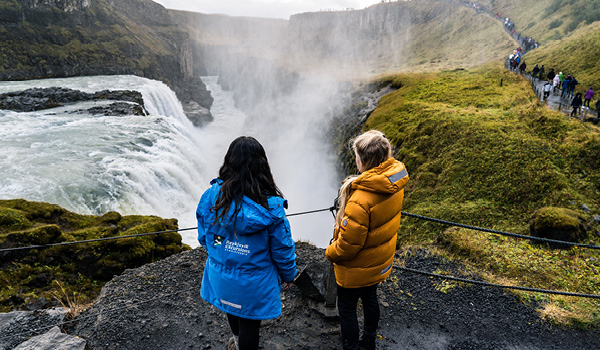
One of the highlights of Iceland, The Golden Circle can be enjoyed all year round. In winter, you can see the mighty cascade of Gullfoss almost frozen over and the chasm of Þingvellir National Park is coated in snow. Strokkur, the explosive geyser, still erupts like clockwork, but there’s something dramatic about seeing it against a snowy landscape in winter. If you plan to visit the sights of the Golden Circle in winter, an organised tour is a better option than driving yourself as the roads can be affected by bad weather and the right vehicle and an experienced Icelandic driver are a good idea.
In summer and spring, the Golden Circle is just as enthralling, when waterfalls are flanked by mossy cliffs and wildflowers bloom in the meadows around Þingvellir. The balmy weather and sunny days mean you don’t have to worry about the day being a wash-out or roads being closed due to snowfall.
Best time to visit Iceland to see the Northern lights

It’s possible to spot the Northern Lights in Iceland between September and March. However, visiting in deepest, darkest winter increases these chances significantly. The long nights between December and February offer the best chance of spotting this unique sight.
Heading out of the city and away from the light pollution also increases your chance of spotting the Northern Lights. Reykjavik Excursions offer a selection of tours to spot the Northern Lights, where an expert can guide you to the best spot each night, and help you capture the perfect snap of the lights dancing against the night sky. You can even pair a Northern Lights excursion with a trip to a geothermal lagoon.
Best time to visit the Blue Lagoon and hot springs in Iceland
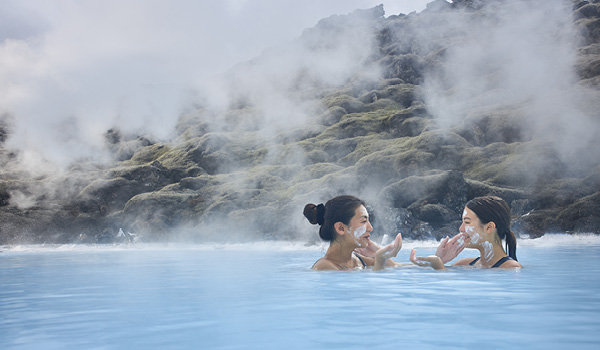
Iceland’s thermal lagoons and hot springs, including the Blue Lagoon, Secret Lagoon and Sky Lagoon, are a joy year-round. The Sky Lagoon is one of the best spots to celebrate the summer solstice in June when you can experience the midnight sun shimmering over the ocean view from the warmth of the water. The Blue Lagoon is the perfect spot to unwind before a long-haul flight, or just after you’ve arrived in Iceland as it’s very close to Keflavik Airport. Summer sees longer opening hours at the Blue Lagoon and Sky Lagoon.
The volcanic landscape of moss and black earth around the Blue Lagoon barely changes with the seasons. So, whether you’re visiting Iceland in spring, autumn or summer, you’ll likely have the same experience at the Blue Lagoon. Looking out over the wild Atlantic Sea, the Sky Lagoon’s view changes with the season. In summer you can admire a blue sea and sky, where it’s impossible to tell where one ends and the other begins. In winter, you can watch dramatic storms build out over the Atlantic from the warmth of the lagoon’s water. Tours and transfers to the Sky Lagoon run year-round.
In winter, there’s something particularly cosy about slipping into the bath-warm water of the Blue Lagoon and Iceland’s other geothermal pools as dramatic stormy skies snow overhead, and your bones really appreciate the warmth after a day of sightseeing in winter. There’s also the chance to spot the Northern Lights from the warmth of the water in the winter months. Reykjavik Excursions run a number of tours and transfers to the Blue Lagoon throughout the year, so whether you want to witness the ethereal milky blue water in the sunshine of summer, or as the Northern Lights put on a spectacular show above, you don’t have to worry about how to get there.
Best time to visit Iceland for the South Coast

You’ll find a litany of natural wonders along the South Coast of Iceland. Here, quaint fishing villages sit by black-sanded beaches, waterfalls look like fairytale illustrations and you can experience the Arctic scenery of the Jökulsárlón Glacier Lagoon and the neighbouring Diamond Beach. Summer sees the glacial icebergs floating in Jökulsárlón lagoon illuminated ethereal blue in the sunlight, and the diamond shards of ice that sit on the black sand at Diamond Beach sparkle during the day. Skogafoss is impressive year-round, but you’re more likely to see the famous rainbow mist around it in summer as the sun reflects off the water spray.
In winter, the sea is restless and waves crash dramatically against the black-sanded beach at Vik. You can admire Skogafoss surrounded by snowy hills and the constant state of sunset during the daylight hours attracts photographers to the Diamond Beach where the icebergs on the shore look as though they glow with golden light. Shorter days and the distance from Reykjavik mean that taking a tour of Iceland’s South Coast is the best option in winter. Adverse weather can affect roads and it’s a long way to drive. Tours have been timed to fit with the season, so in winter, you stand a much better chance of seeing Jökulsárlón Lagoon in the daylight if you take a tour.
Best time to visit Iceland for hiking
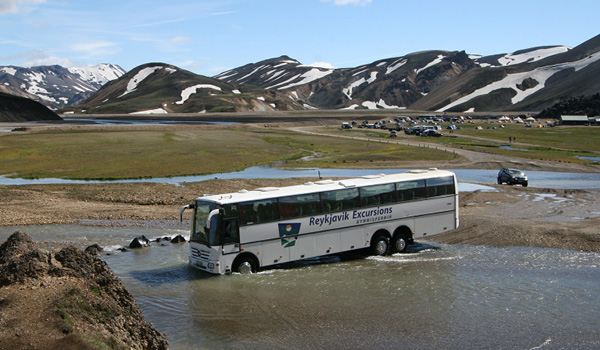
If you want to hike through Iceland’s unspoilt interior, it has to be a visit in summer. During the winter months the Highlands are cut off from the rest of the country as stormy weather and snowfall makes the narrow, mountain roads impossible to pass. Even in summer, travelling by 4x4 is recommended to reach the wild interior of Iceland as there are glacial rivers to be forded and unpaved roads aplenty. Hiking in this region rewards with other-worldly sights like hills tinged turquoise with iron deposits and empty, rugged scenery as far as they eye can see. Trails are well-marked, so you can get a bus transfer to Landmannalaugar, at the start of the popular Laugavegur trail and head off under your own steam. You can also go on a guided Laugavegur Trek, where the accommodation in mountain huts, transfer and food is all included.
There are a few low-altitude hikes that can be attempted in winter in Iceland. The Reykjadalur Hot Spring Hike is a popular one for the colder months. However, summer and late spring are really the best time to embark on a hiking trip to Iceland because, in winter, the weather can be harsh and very changeable from one minute to the next and it’s safer to stay around the coast.
Best time to visit Iceland for ice caves
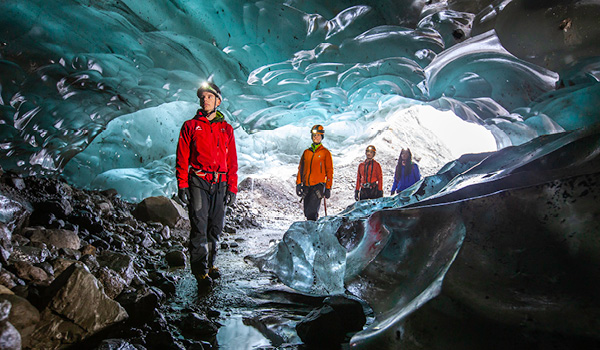
Like the Northern Lights, the ice caves of Iceland are a distinctly winter activity. At Vatnajokull, said to be the most beautiful ice cave, the warmer temperatures of summer mean the ice slowly melts and the way in is too dangerous between the end of March and beginning of November. So, between November and March you can embark on a unique walk through the Vatnajokull ice cave. Glowing blue and hewn into glacial ice, walking through an ice cave is the sleek, frozen world you expect from an Arctic wonderland.
If you visit in summer and really want to experience an ice cave, the Langjokull tunnel offers a man-made alternative to the natural cave of Vatnajokull. Reykjavik Excursions runs ice cave tours to both Vatnajokull and Langjokull, which can be paired with a glacier hike, a boat ride in the glacier lagoon or perhaps a day of sightseeing on the South Coast.
Best time to visit Iceland for the midnight sun
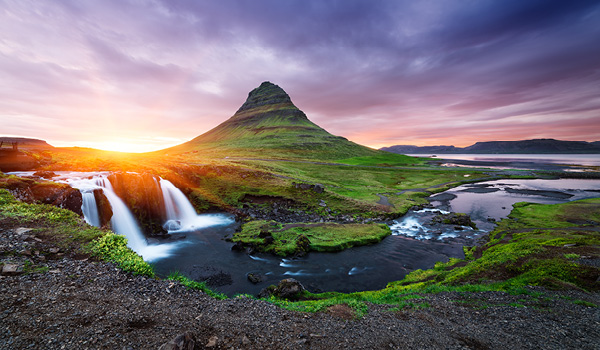
The midnight sun itself, when the sun doesn’t officially set until after 12am, is only visible a few days of the year. Usually the 21st June is the summer solstice, officially the longest day of the year, when the midnight sun is guaranteed. For a few days around this date, there’s almost 24 hours of daylight. Throughout the months of June and July the sunset usually takes place before midnight but, since the sun barely dips below the horizon, even after the sun has for a couple of hours, there is still lightness in the sky so it never really gets dark during this time of year.
Best time to visit Iceland for whale watching
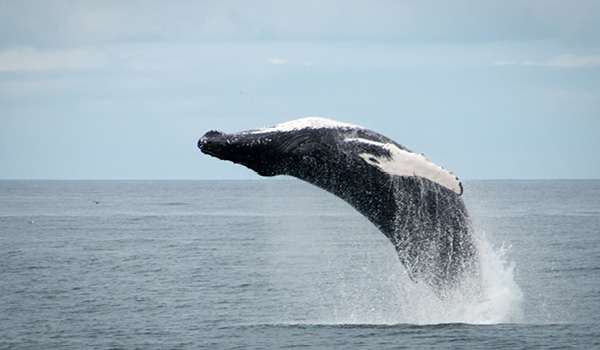
The peak season for whale watching in Iceland is between May and September, when you can spot around 20 different species of whale, from mink to humpback and even blue whales breaching the water. Boat trips run from Husavik and Reykjavik in these months, and the long daylight hours mean evening whale watching tours are an option.
In winter, large scholes of herring attract the striking black and white orca whales to Iceland’s shores, especially in February and March. Boat trips to spot orcas usually leave from the Snaefellsnes Peninsula.
Reykjavik Excursions offer a range of whale watching trips out to Faxaflói Bay from Reykjavik and from Akureyri in the north. You can combine whale watching with an angling session or puffin spotting.
How many days in Iceland is enough?
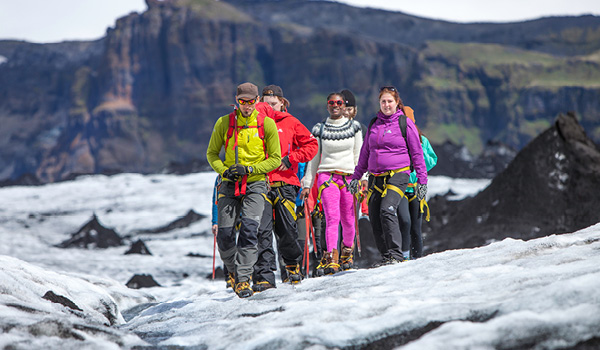
The beauty of Iceland is that it can be a two-week long holiday destination, a weekend short break, or a stop-over, breaking up long-haul flights between Europe and North America. You can see essential Iceland in two to three days by fitting in the Golden Circle, the Blue Lagoon and perhaps the sights of the South Coast. If you’re pushed for time, Reykjavik Excursions offer multi-day tours, ranging from two to seven days, taking the hassle out of planning, and ensuring you don’t miss out on any of the essentials.
You could easily spend a week, ten days or even two weeks in Iceland too. The circular Route One road follows the coast of the island, and makes for an excellent week-long adventure, stopping of at Iceland’s natural wonders along the way. More than a few days in Iceland also means you can experience some of the lesser-known spots – the rugged Highlands in the interior, glacial walks and ice caves.
Now that we’ve covered the best time of year to visit Iceland, you can decide if you want a winter break, or a summer sojourn. If hiking and whale watching are your thing, or if you want to witness the magic of the midnight sun, the long summer days in Iceland are for you. But if you want to hunt for the Northern Lights or spend your days exploring the shimmering blue ice caves, it should be a winter holiday. The shoulder seasons of spring and autumn might offer a compromise on the weather, and both seasons see less crowds along the Golden Circle and sights of the South Coast. Whichever season you choose to visit Iceland in, Reykjavik Excursions has you covered with organised day trips, transfers to geothermal lagoons throughout the year, and multi-day adventures to make the most of short trips.
Tours in the spotlight
REYKJAVIK EXCURSIONS BLOG
Get inspired! Information and tips and must see places in Iceland, fun facts, customs and more.
The Silver Circle of West Iceland - Your Guide
You’ve heard of the Golden Circle, but here’s why you should head to Iceland’s western region to explore the msytical Silver Circle tour route.
Read BlogBest time to visit Iceland - your guide
June 24, 2022
Best time to visit Iceland - your guide
June 24, 2022
Cast out in the wild North Atlantic, Iceland is a rugged island of coastal fishing towns, raw wilderness and geothermal natural wonders. The best time to visit Iceland depends on your interests. If you want to witness a world blanketed in snow as the Northern Lights dance above, or explore the glowing blue interior of an ice cave, consider the winter months. If you’re looking to hike in the unspoilt scenery of the Highlands, or embark on a whale watching boat trip, summer might be the season for you. Whatever draws you to this unique little island, and whether you want to visit Iceland in summer or winter, we’ve compiled the ultimate guide to Iceland’s seasons and sights so you can decide the best time of year to visit Iceland for your trip.
When is the best time to visit Iceland?
If we went on numbers alone, the statistics would suggest that June to August is the best time to visit Iceland. This is considered peak season, when the most visitors flock to the island to take advantage of the long, light evenings and pleasant weather. If you want to witness the midnight sun on the longest day of the year when the solstice is celebrated in Iceland, best time to visit would be around 21st June.
If spotting the Northern Lights is at the top of your bucket list, you’ll want to avoid the summer months when the sun barely sets and head to Iceland in deepest darkest winter. The long nights give you the best chance of spotting the aurora borealis. This is also the perfect time to enjoy Iceland’s traditional bathing culture in geothermal pools like the Blue Lagoon and Sky Lagoon. There’s something magical about having a long, hot soak in a natural thermal pool as snow falls around you.
What is the best month to visit Iceland?
As we’ve mentioned, the summer months, between June and August are when the days are long and sightseeing can last long into the evening. At the end of June, the sun barely sets below to horizon and you can enjoy daylight for almost 24 hours of the day. This is also the season to head into the centre of Iceland – the raw, unspoilt wilderness of the Highlands. Outside of the summer months, the Highlands are inaccessible as they can only be reached by narrow mountain roads and crossing glacial rivers in a 4x4, so the snowfall in winters cuts off the interior from the rest of the country.
Autumn is a good choice if you don’t want to feel the deep cold of winter and prefer your sunsets at around 6pm or 7pm. You have a chance to spot the Northern Lights from September through to March, so heading to Iceland in September, October or November could still reward with a sighting of this other-worldly phenomena without having to endure the harsh temperatures of winter. This is also shoulder season when the streets of Reykjavik and the sights of the Golden Circle are less crowded with visitors.
Iceland does make for an excellent winter break though. In December, January and February, you have the best chance to spot the Northern Lights as the sun sets as early as 3pm some days. Even when the sun shines in these months, it feels as though the country is in a constant state of sunset, bathed in golden light during the limited daylight hours. It’s a photographer’s dream to visit Iceland in the winter months.
Spring can be a good compromise if you want to enjoy the sunshine without the crowds. There’s still a chance to spot the Northern Lights in March, but there’s more of a risk of missing out than in the winter months. April and May see the temperature rise and stormclouds clear, and days get longer.
Best time to visit Iceland to see the Golden Circle

One of the highlights of Iceland, The Golden Circle can be enjoyed all year round. In winter, you can see the mighty cascade of Gullfoss almost frozen over and the chasm of Þingvellir National Park is coated in snow. Strokkur, the explosive geyser, still erupts like clockwork, but there’s something dramatic about seeing it against a snowy landscape in winter. If you plan to visit the sights of the Golden Circle in winter, an organised tour is a better option than driving yourself as the roads can be affected by bad weather and the right vehicle and an experienced Icelandic driver are a good idea.
In summer and spring, the Golden Circle is just as enthralling, when waterfalls are flanked by mossy cliffs and wildflowers bloom in the meadows around Þingvellir. The balmy weather and sunny days mean you don’t have to worry about the day being a wash-out or roads being closed due to snowfall.
Best time to visit Iceland to see the Northern lights

It’s possible to spot the Northern Lights in Iceland between September and March. However, visiting in deepest, darkest winter increases these chances significantly. The long nights between December and February offer the best chance of spotting this unique sight.
Heading out of the city and away from the light pollution also increases your chance of spotting the Northern Lights. Reykjavik Excursions offer a selection of tours to spot the Northern Lights, where an expert can guide you to the best spot each night, and help you capture the perfect snap of the lights dancing against the night sky. You can even pair a Northern Lights excursion with a trip to a geothermal lagoon.
Best time to visit the Blue Lagoon and hot springs in Iceland

Iceland’s thermal lagoons and hot springs, including the Blue Lagoon, Secret Lagoon and Sky Lagoon, are a joy year-round. The Sky Lagoon is one of the best spots to celebrate the summer solstice in June when you can experience the midnight sun shimmering over the ocean view from the warmth of the water. The Blue Lagoon is the perfect spot to unwind before a long-haul flight, or just after you’ve arrived in Iceland as it’s very close to Keflavik Airport. Summer sees longer opening hours at the Blue Lagoon and Sky Lagoon.
The volcanic landscape of moss and black earth around the Blue Lagoon barely changes with the seasons. So, whether you’re visiting Iceland in spring, autumn or summer, you’ll likely have the same experience at the Blue Lagoon. Looking out over the wild Atlantic Sea, the Sky Lagoon’s view changes with the season. In summer you can admire a blue sea and sky, where it’s impossible to tell where one ends and the other begins. In winter, you can watch dramatic storms build out over the Atlantic from the warmth of the lagoon’s water. Tours and transfers to the Sky Lagoon run year-round.
In winter, there’s something particularly cosy about slipping into the bath-warm water of the Blue Lagoon and Iceland’s other geothermal pools as dramatic stormy skies snow overhead, and your bones really appreciate the warmth after a day of sightseeing in winter. There’s also the chance to spot the Northern Lights from the warmth of the water in the winter months. Reykjavik Excursions run a number of tours and transfers to the Blue Lagoon throughout the year, so whether you want to witness the ethereal milky blue water in the sunshine of summer, or as the Northern Lights put on a spectacular show above, you don’t have to worry about how to get there.
Best time to visit Iceland for the South Coast

You’ll find a litany of natural wonders along the South Coast of Iceland. Here, quaint fishing villages sit by black-sanded beaches, waterfalls look like fairytale illustrations and you can experience the Arctic scenery of the Jökulsárlón Glacier Lagoon and the neighbouring Diamond Beach. Summer sees the glacial icebergs floating in Jökulsárlón lagoon illuminated ethereal blue in the sunlight, and the diamond shards of ice that sit on the black sand at Diamond Beach sparkle during the day. Skogafoss is impressive year-round, but you’re more likely to see the famous rainbow mist around it in summer as the sun reflects off the water spray.
In winter, the sea is restless and waves crash dramatically against the black-sanded beach at Vik. You can admire Skogafoss surrounded by snowy hills and the constant state of sunset during the daylight hours attracts photographers to the Diamond Beach where the icebergs on the shore look as though they glow with golden light. Shorter days and the distance from Reykjavik mean that taking a tour of Iceland’s South Coast is the best option in winter. Adverse weather can affect roads and it’s a long way to drive. Tours have been timed to fit with the season, so in winter, you stand a much better chance of seeing Jökulsárlón Lagoon in the daylight if you take a tour.
Best time to visit Iceland for hiking

If you want to hike through Iceland’s unspoilt interior, it has to be a visit in summer. During the winter months the Highlands are cut off from the rest of the country as stormy weather and snowfall makes the narrow, mountain roads impossible to pass. Even in summer, travelling by 4x4 is recommended to reach the wild interior of Iceland as there are glacial rivers to be forded and unpaved roads aplenty. Hiking in this region rewards with other-worldly sights like hills tinged turquoise with iron deposits and empty, rugged scenery as far as they eye can see. Trails are well-marked, so you can get a bus transfer to Landmannalaugar, at the start of the popular Laugavegur trail and head off under your own steam. You can also go on a guided Laugavegur Trek, where the accommodation in mountain huts, transfer and food is all included.
There are a few low-altitude hikes that can be attempted in winter in Iceland. The Reykjadalur Hot Spring Hike is a popular one for the colder months. However, summer and late spring are really the best time to embark on a hiking trip to Iceland because, in winter, the weather can be harsh and very changeable from one minute to the next and it’s safer to stay around the coast.
Best time to visit Iceland for ice caves

Like the Northern Lights, the ice caves of Iceland are a distinctly winter activity. At Vatnajokull, said to be the most beautiful ice cave, the warmer temperatures of summer mean the ice slowly melts and the way in is too dangerous between the end of March and beginning of November. So, between November and March you can embark on a unique walk through the Vatnajokull ice cave. Glowing blue and hewn into glacial ice, walking through an ice cave is the sleek, frozen world you expect from an Arctic wonderland.
If you visit in summer and really want to experience an ice cave, the Langjokull tunnel offers a man-made alternative to the natural cave of Vatnajokull. Reykjavik Excursions runs ice cave tours to both Vatnajokull and Langjokull, which can be paired with a glacier hike, a boat ride in the glacier lagoon or perhaps a day of sightseeing on the South Coast.
Best time to visit Iceland for the midnight sun

The midnight sun itself, when the sun doesn’t officially set until after 12am, is only visible a few days of the year. Usually the 21st June is the summer solstice, officially the longest day of the year, when the midnight sun is guaranteed. For a few days around this date, there’s almost 24 hours of daylight. Throughout the months of June and July the sunset usually takes place before midnight but, since the sun barely dips below the horizon, even after the sun has for a couple of hours, there is still lightness in the sky so it never really gets dark during this time of year.
Best time to visit Iceland for whale watching

The peak season for whale watching in Iceland is between May and September, when you can spot around 20 different species of whale, from mink to humpback and even blue whales breaching the water. Boat trips run from Husavik and Reykjavik in these months, and the long daylight hours mean evening whale watching tours are an option.
In winter, large scholes of herring attract the striking black and white orca whales to Iceland’s shores, especially in February and March. Boat trips to spot orcas usually leave from the Snaefellsnes Peninsula.
Reykjavik Excursions offer a range of whale watching trips out to Faxaflói Bay from Reykjavik and from Akureyri in the north. You can combine whale watching with an angling session or puffin spotting.
How many days in Iceland is enough?

The beauty of Iceland is that it can be a two-week long holiday destination, a weekend short break, or a stop-over, breaking up long-haul flights between Europe and North America. You can see essential Iceland in two to three days by fitting in the Golden Circle, the Blue Lagoon and perhaps the sights of the South Coast. If you’re pushed for time, Reykjavik Excursions offer multi-day tours, ranging from two to seven days, taking the hassle out of planning, and ensuring you don’t miss out on any of the essentials.
You could easily spend a week, ten days or even two weeks in Iceland too. The circular Route One road follows the coast of the island, and makes for an excellent week-long adventure, stopping of at Iceland’s natural wonders along the way. More than a few days in Iceland also means you can experience some of the lesser-known spots – the rugged Highlands in the interior, glacial walks and ice caves.
Now that we’ve covered the best time of year to visit Iceland, you can decide if you want a winter break, or a summer sojourn. If hiking and whale watching are your thing, or if you want to witness the magic of the midnight sun, the long summer days in Iceland are for you. But if you want to hunt for the Northern Lights or spend your days exploring the shimmering blue ice caves, it should be a winter holiday. The shoulder seasons of spring and autumn might offer a compromise on the weather, and both seasons see less crowds along the Golden Circle and sights of the South Coast. Whichever season you choose to visit Iceland in, Reykjavik Excursions has you covered with organised day trips, transfers to geothermal lagoons throughout the year, and multi-day adventures to make the most of short trips.
Tours in the spotlight
REYKJAVIK EXCURSIONS BLOG
Get inspired! Information and tips and must see places in Iceland, fun facts, customs and more.
The Silver Circle of West Iceland - Your Guide
You’ve heard of the Golden Circle, but here’s why you should head to Iceland’s western region to explore the msytical Silver Circle tour route.
Read Blog